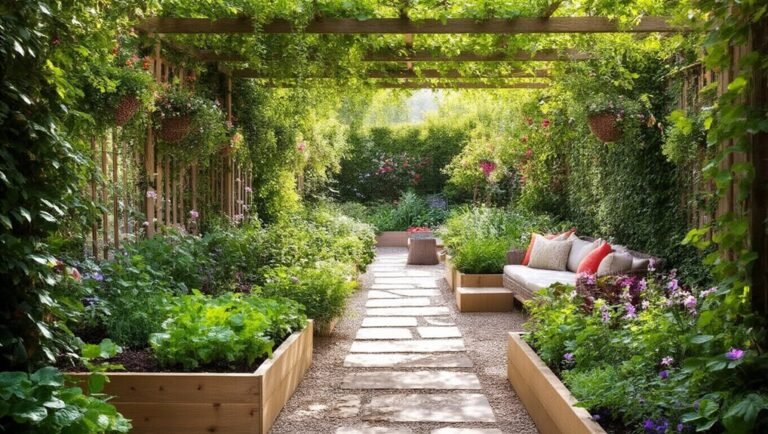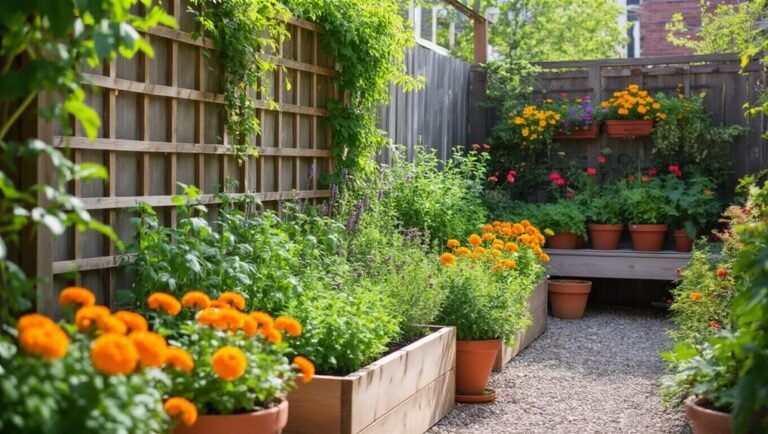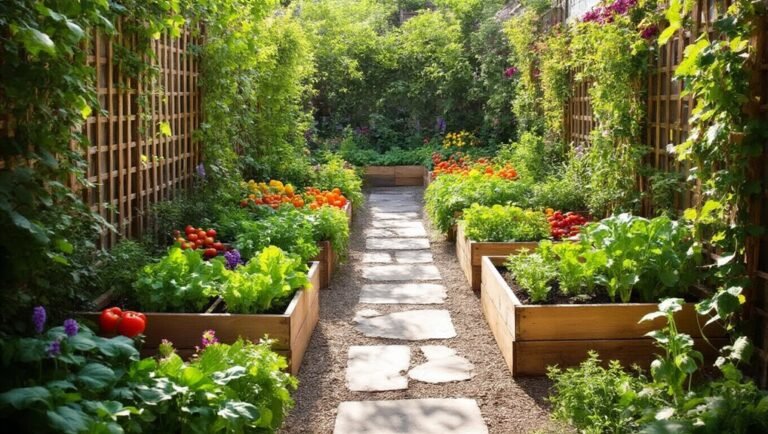You’ve just harvested your first vegetable, and it’s time to enjoy it! Toss it into a crisp salad with a light vinaigrette, or sauté it with garlic and herbs in olive oil. Make sure to store any extras properly to keep them fresh, and consider sharing your bounty with friends or neighbors. If you’re excited about future harvests, there are plenty of ways to plan what to plant next, so keep exploring!
Key Takeaways
- Clean your harvested vegetable gently and store it properly to maintain freshness.
- Enjoy your produce immediately by incorporating it into salads, stir-fries, or soups.
- Share your bounty by hosting a potluck or giving gift baskets to friends.
- Preserve any excess by canning, blanching, or freezing for later use.
- Plan for future harvests by researching seasonal planting and companion planting techniques.
Enjoying Fresh Veggies: Delicious Recipe Ideas
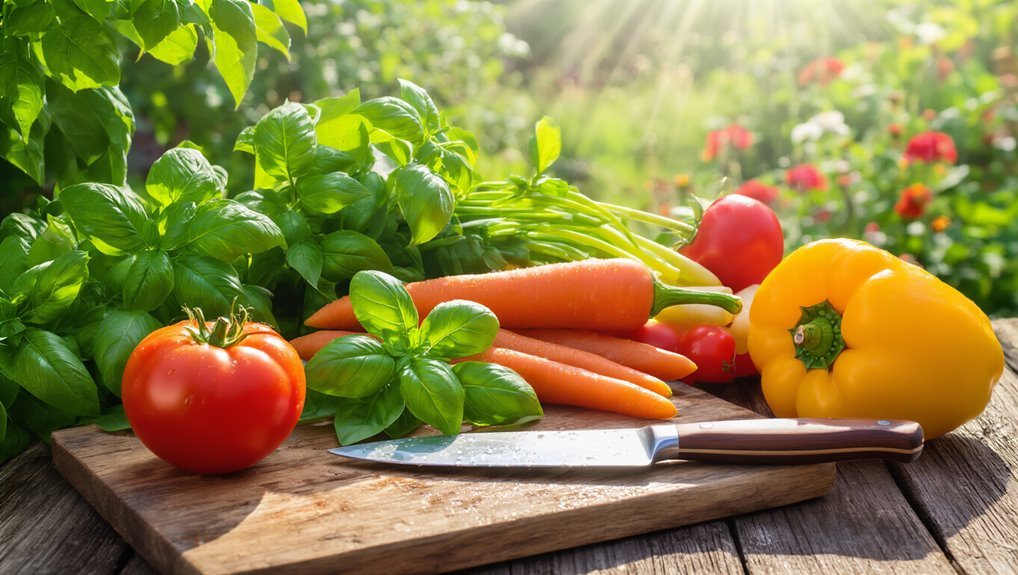
Once you’ve harvested your first vegetables, you might be eager to savor their freshness in your meals.
Try tossing your veggies into a crisp salad with a light vinaigrette. If you’ve got tomatoes and cucumbers, add some feta cheese for a delightful twist. Starting with a seed starting kit can help ensure a steady supply of homegrown veggies for future salads.
Another option is to sauté your harvest in olive oil, seasoning with garlic and herbs for a simple yet flavorful side dish.
You can even whip up a vegetable stir-fry, mixing in your favorites with soy sauce and sesame oil.
For a heartier meal, consider making a vegetable soup or stew, letting the flavors meld beautifully.
If you’re looking to expand your gardening toolkit, consider learning about garden trowels to make your next harvest even easier.
Whatever you choose, enjoy the vibrant taste and satisfaction of using your homegrown produce!
Proper Storage Techniques for Longevity
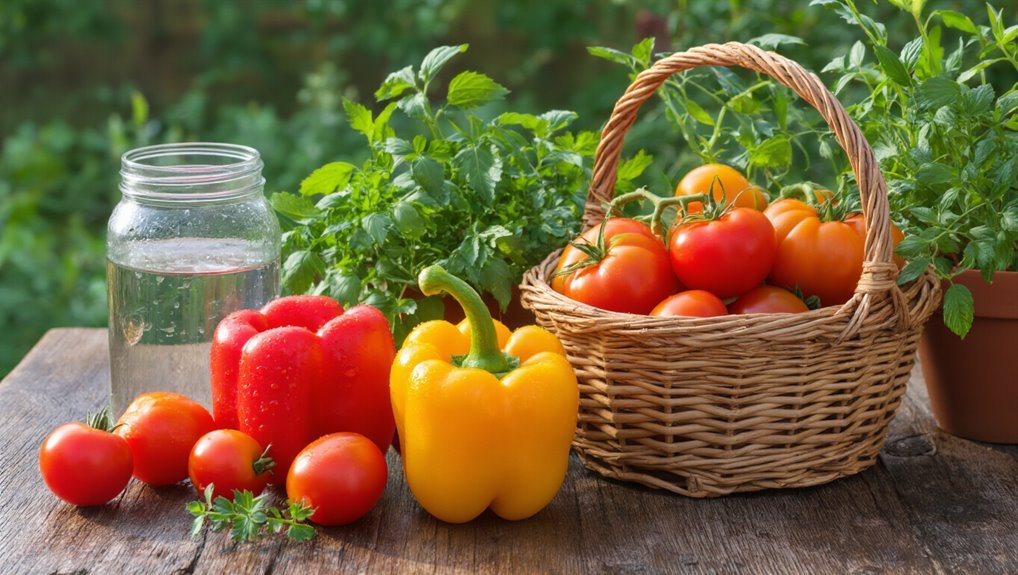
After enjoying the delicious flavors of your freshly harvested vegetables, it’s important to think about how to store them properly to maintain their quality and extend their shelf life.
Start by cleaning your veggies gently to remove dirt, then dry them thoroughly. For leafy greens, wrap them in a damp paper towel and place them in a breathable bag in the fridge. Incorporating outdoor composting systems into your routine can help manage any vegetable waste efficiently.
Root vegetables, like carrots and potatoes, do best in a cool, dark place, ideally in a mesh bag or basket. Avoid washing them until you’re ready to use them.
For longer storage, consider blanching and freezing techniques. Remember, the right storage conditions can keep your harvest fresh and tasty for weeks!
If you have leftover scraps or spoiled produce, consider using them in a compost bin to enrich your garden soil and reduce waste.
Creative Ways to Share Your Harvest
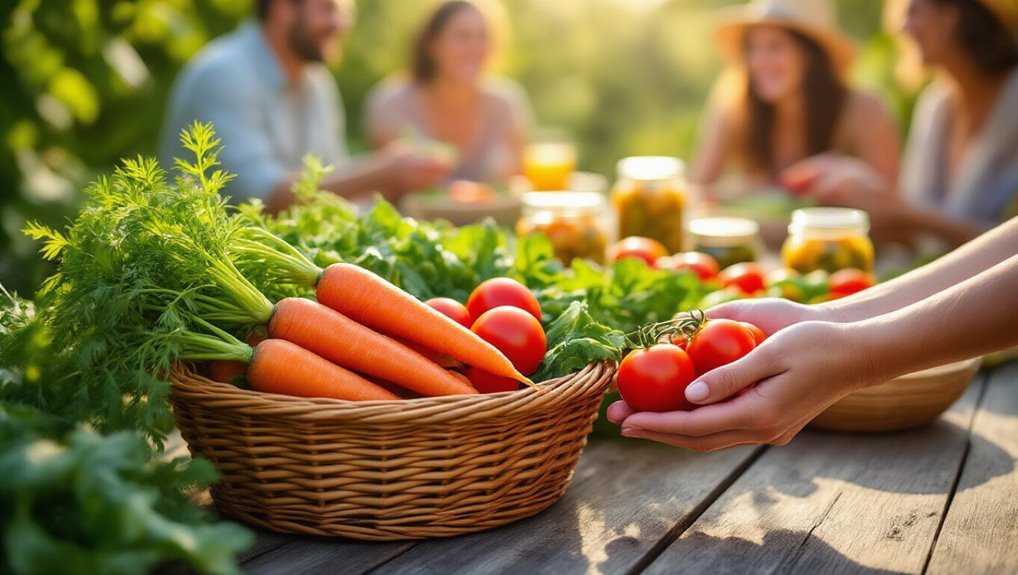
Sharing your harvest can be as rewarding as growing it, especially when you find creative ways to do so.
Consider hosting a neighborhood potluck where everyone brings a dish made from their own produce. You can also create beautiful gift baskets filled with your vegetables to share with friends or family. Adding a decorative birdhouse for gardens near your gathering area can enhance the atmosphere and attract feathered friends to your celebration.
If you’re feeling adventurous, try organizing a “swap” event where you trade your extras for items from others’ gardens. Donating to local food banks or shelters is another generous option.
You might even start a small community garden, inviting folks to join in the fun.
If you’re seeking more inspiration, browsing gardening magazine subscriptions can introduce you to even more creative ways to share and celebrate your harvest with others.
Whatever you choose, sharing not only spreads joy but also fosters connections with those around you. Enjoy the fruits of your labor together!
Preserving Your Produce: Canning and Freezing
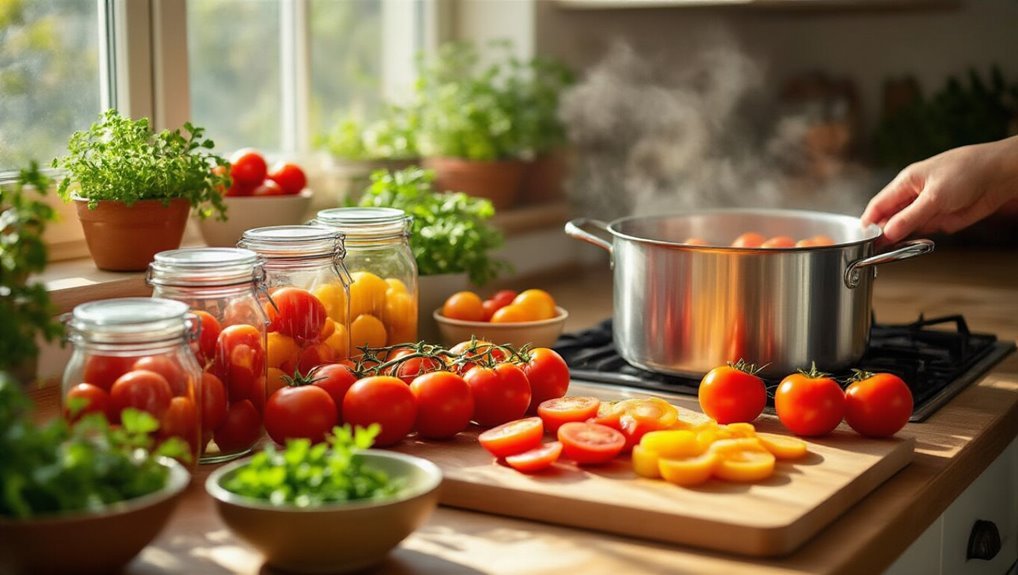
While enjoying your fresh vegetables, you might find yourself wondering how to make them last beyond the harvest season. Canning and freezing are two excellent methods to preserve your bounty.
For canning, start by sterilizing your jars and lids. Blanch your vegetables briefly, then pack them into jars with the appropriate liquid, leaving enough headspace. Seal them tightly and process in a water bath or pressure canner according to your recipe. If you’re interested in expanding your skills, consider starting with herb garden kits to grow a variety of herbs that can also be preserved.
Freezing is simpler; wash, peel, and chop your veggies as needed. Blanch them for a few minutes to preserve color and texture, then cool and pack them into airtight bags or containers. Label them with the date, and you’ll enjoy your harvest long after the growing season ends! If you want to preserve herbs, consider using herb drying racks to efficiently dry and store your kitchen herbs for year-round use.
Exploring New Cooking Methods
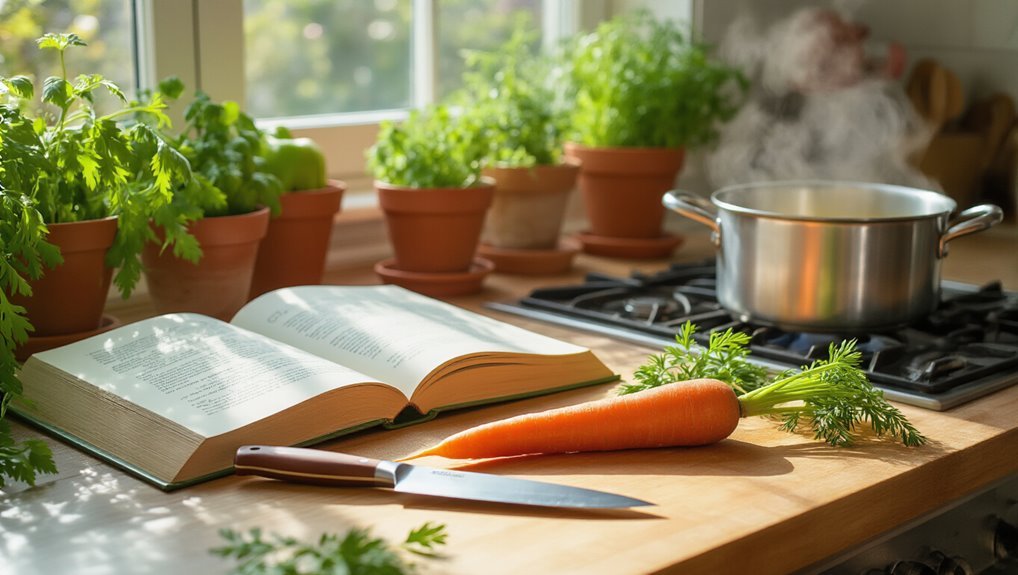
As you relish the flavors of your freshly harvested vegetables, experimenting with new cooking methods can elevate your culinary experience. Try steaming, roasting, or stir-frying to bring out unique tastes and textures. Each method can transform your veggies in delightful ways.
Here’s a quick guide to help you choose:
| Cooking Method | Flavor Profile |
|---|---|
| Steaming | Retains natural flavors and nutrients |
| Roasting | Enhances sweetness and adds a crispy texture |
| Stir-frying | Quick cooking with vibrant flavors |
| Grilling | Imparts a smoky taste and charred texture |
Planning for Future Harvests: What to Plant Next
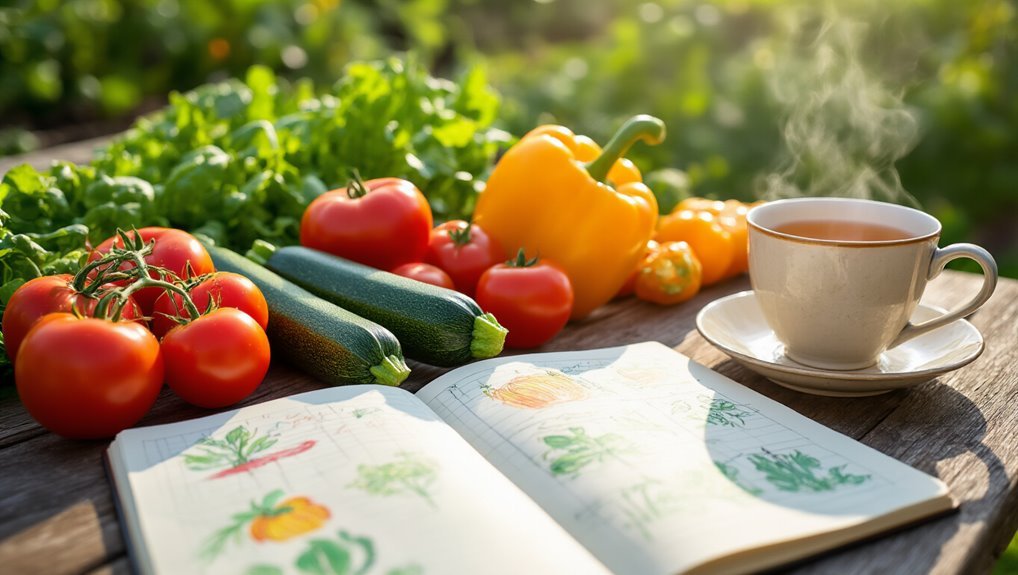
To ensure your garden continues to thrive, it’s essential to plan what to plant next after enjoying your first harvest.
Consider your growing season and what crops will flourish. Here are three ideas to get you started:
- Succession Planting: If your first crop has finished, plant a quick-growing vegetable like radishes or lettuce to maximize space and yield.
- Seasonal Varieties: Think about what you want to eat in the coming months. If you loved your tomatoes, consider planting a late-season variety.
- Companion Planting: Pair new plants with existing ones to enhance growth. For example, plant basil near your tomatoes to improve flavor and deter pests.
Frequently Asked Questions
How Do I Know When My Vegetables Are Ripe for Harvest?
To know when your vegetables are ripe for harvest, check their color, size, and firmness. Research specific varieties, observe growth patterns, and trust your instincts. You’ll develop a keen eye for ripeness over time.
What Should I Do if I Have a Pest Problem?
Pest problems plague your plants? First, pinpoint the pests and their presence. Then, consider chemical or natural controls, like neem oil or insecticidal soap. Finally, practice prevention with proper hygiene and healthy habitats for your garden.
Can I Grow Vegetables in Containers or Small Spaces?
Absolutely, you can grow vegetables in containers or small spaces! Choose compact varieties, use quality potting soil, and ensure adequate sunlight. Regular watering and feeding will help your plants thrive even in limited areas.
How Do I Identify and Treat Plant Diseases?
To identify plant diseases, check for unusual spots, wilting, or discoloration. Treat them by removing affected leaves, improving air circulation, and applying appropriate organic fungicides or pesticides. Always research specific diseases for targeted solutions.
What Tools Do I Need for Vegetable Gardening?
You’ll need a magical toolkit to conquer the vegetable gardening realm! Grab a sturdy trowel, rake, pruning shears, gloves, and a watering can. With these treasures, your garden’s destiny is in your hands, blooming magnificently!
Conclusion
Now that you’ve reaped the rewards of your hard work, let your culinary creativity take flight. Whether you savor your fresh veggies in a vibrant stir-fry or share them with friends, each bite is a celebration of nature’s bounty. Store them with care, preserve their essence for colder days, and dream of next season’s garden. Embrace the journey from seed to plate—it’s a dance of flavors that keeps your spirit nourished and your table brimming with joy.
